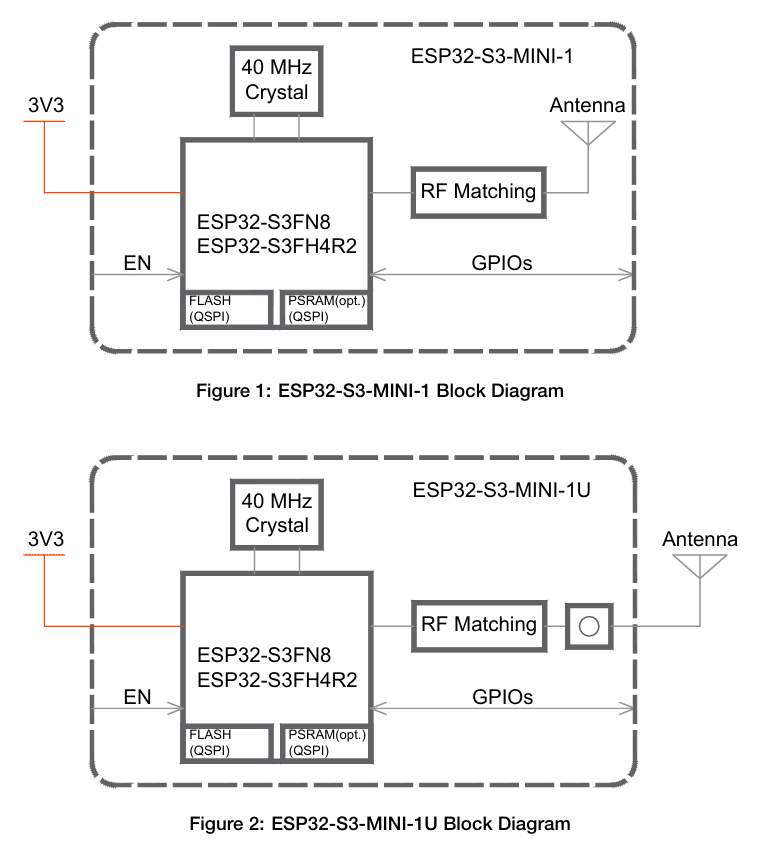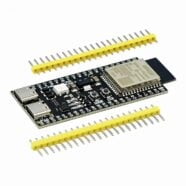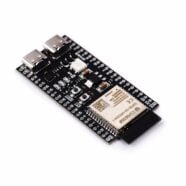Searching for the right ESP32-S3 module for your project? Want to know the characteristics of each? This guide will help with that.
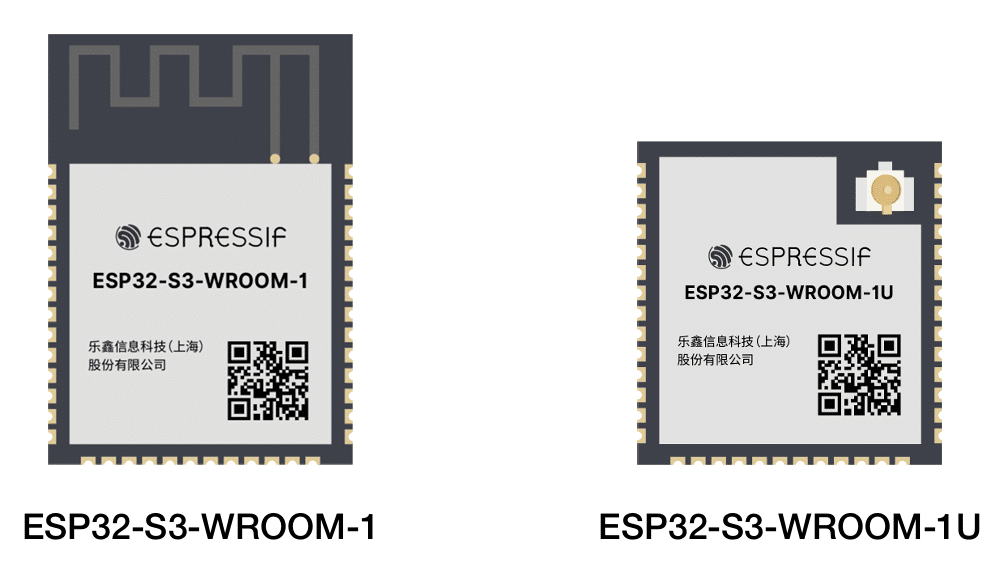
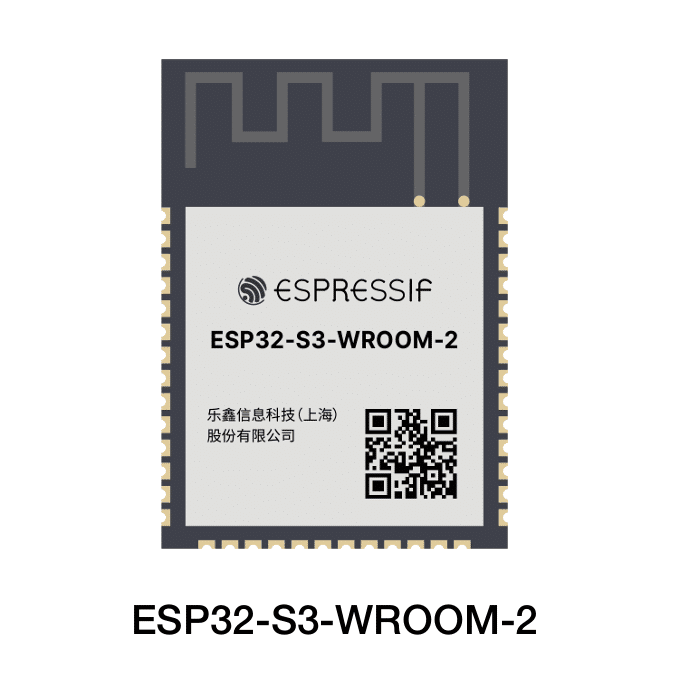

Introduction
ESP32 devices have taken the IoT community by storm. Currently, several of these IoT projects may contain the latest ESP32-S3 module. Interestingly, you may find that there are different ESP32-S3 module variants inside these projects. With this, you may wonder, what are the different characteristics of each of these modules?
What are ESP32 Modules
ESP32 modules are self-contained devices that house all the components needed to run your ESP32-S3 chip. These components include the ESP32-S3 chip, a crystal oscillator, the antenna (PCB type or connector type), optional internal or external PSRAM chips, optional internal or external extended Flash memories, and the necessary passive components to successfully boot and run your ESP32 device.
If you want to learn how to get started, program and run an ESP32 module (specifically, the ESP32 WROOM series), please checkout ESP32 WROOM Series – Getting Started.
The blog post Different Kinds of ESP32 Series Modules previously discussed the different variants of the classic ESP32 modules along with discussing its internals. Now, you’ll learn the current modules for the newer variant, ESP32-S3.
The Differrent Kinds of ESP32-S3 Modules Available Today
eSP32-WROOM-1 and 1U
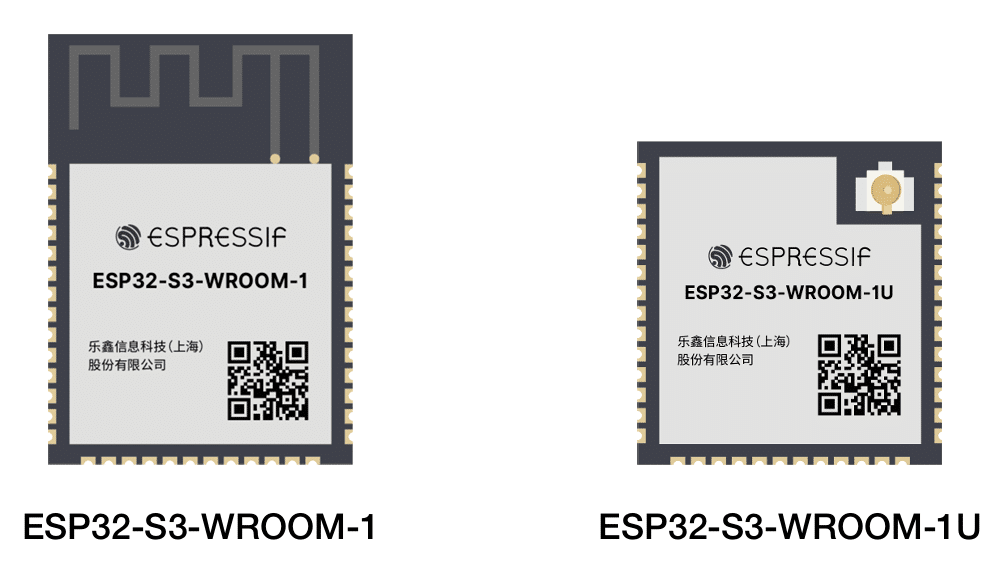
The ESP32-S3-WROOM-1 module series is mounted on a castellated PCB edge board design. This makes it easy to manually solder the module on your projects. The 1 variant has a PCB antenna while the 1U has the antenna connector.
The microcontroller inside is an ESP32-S3 SoC embedded Xtensa® dual-core 32-bit LX7 microprocessor (with single precision FPU), up to 240 MHz. It has both WiFi (802.11 b/g/n) and Bluetooth 5 (LE and Mesh) functionality. The list of peripherals of this microcontroller includes:
- GPIO (up to 36), SPI, LCD interface, Camera interface
- UART, I2C, I2S, remote control, pulse counter
- LED PWM
- full-speed USB 2.0 OTG, USB Serial/JTAG controller
- MCPWM, SDIO host
- GDMA, TWAI® controller
- ADC, touch sensor, temperature sensor
- timers and watchdogs
The ESP32-S3 Soc includes additional vector instructions for neural network computing and signal processing fit for AI and DSP specifc algorithms.
Note that the memories of the ESP32-S3 may vary in an ESP32-S3-WROOM-1. Here are convenient tables to check:
| ESP32-S3-WROOM-1 | Flash | PSRAM |
|---|---|---|
| ESP32-S3-WROOM-1-N4 | 4MB(QuadSPI) | |
| ESP32-S3-WROOM-1-N8 | 8MB(QuadSPI) | |
| ESP32-S3-WROOM-1-N16 | 16MB(QuadSPI) | |
| ESP32-S3-WROOM-1-H4 | 4MB(QuadSPI) | |
| ESP32-S3-WROOM-1-N4R2 | 4MB(QuadSPI) | 2MB(QuadSPI) |
| ESP32-S3-WROOM-1-N8R2 | 8MB(QuadSPI) | 2MB(QuadSPI) |
| ESP32-S3-WROOM-1-N16R2 | 16MB(QuadSPI) | 2MB(QuadSPI) |
| ESP32-S3-WROOM-1-N4R8 | 4MB(QuadSPI) | 8MB(OctalSPI) |
| ESP32-S3-WROOM-1-N8R8 | 8MB(QuadSPI) | 8MB(OctalSPI) |
| ESP32-S3-WROOM-1-N16R8 | 16MB(QuadSPI) | 8MB(OctalSPI) |
| ESP32-S3-WROOM-1-N16R16V | 16MB(QuadSPI) | 16MB(OctalSPI) |
| ESP32-S3-WROOM-1U | Flash | PSRAM |
|---|---|---|
| ESP32-S3-WROOM-1U-N4 | 4MB(QuadSPI) | |
| ESP32-S3-WROOM-1U-N8 | 8MB(QuadSPI) | |
| ESP32-S3-WROOM-1U-N16 | 16MB(QuadSPI) | |
| ESP32-S3-WROOM-1U-H4 | 4MB(QuadSPI) | |
| ESP32-S3-WROOM-1U-N4R2 | 4MB(QuadSPI) | 2MB(QuadSPI) |
| ESP32-S3-WROOM-1U-N8R2 | 8MB(QuadSPI) | 2MB(QuadSPI) |
| ESP32-S3-WROOM-1U-N16R2 | 16MB(QuadSPI) | 2MB(QuadSPI) |
| ESP32-S3-WROOM-1U-N4R8 | 4MB(QuadSPI) | 8MB(OctalSPI) |
| ESP32-S3-WROOM-1U-N8R8 | 8MB(QuadSPI) | 8MB(OctalSPI) |
| ESP32-S3-WROOM-1U-N16R8 | 16MB(QuadSPI) | 8MB(OctalSPI) |
| ESP32-S3-WROOM-1U-N16R16V | 16MB(QuadSPI) | 16MB(OctalSPI) |
If you’ll notice, the flash of the ESP32-S3-WROOM-1 is connected in QuadSPI while it’s PSRAM in QuadSPI or OctalSPI. Note that memories connected in OctalSPI have interface speed advantages compared to QuadSPI.
Here are the internal block diagrams of an ESP32-WROOM-1
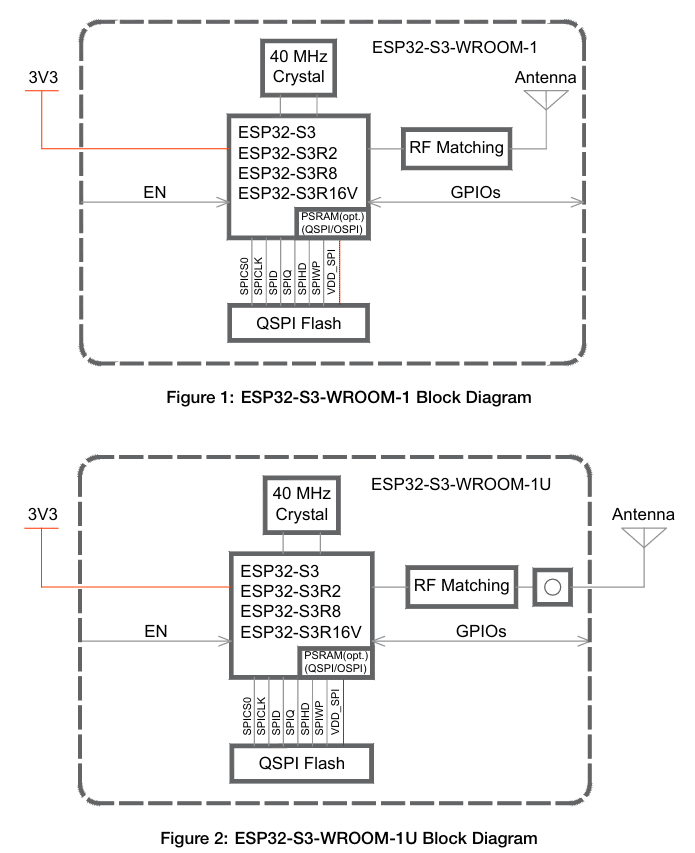
ESP32-S3-WROOM-2
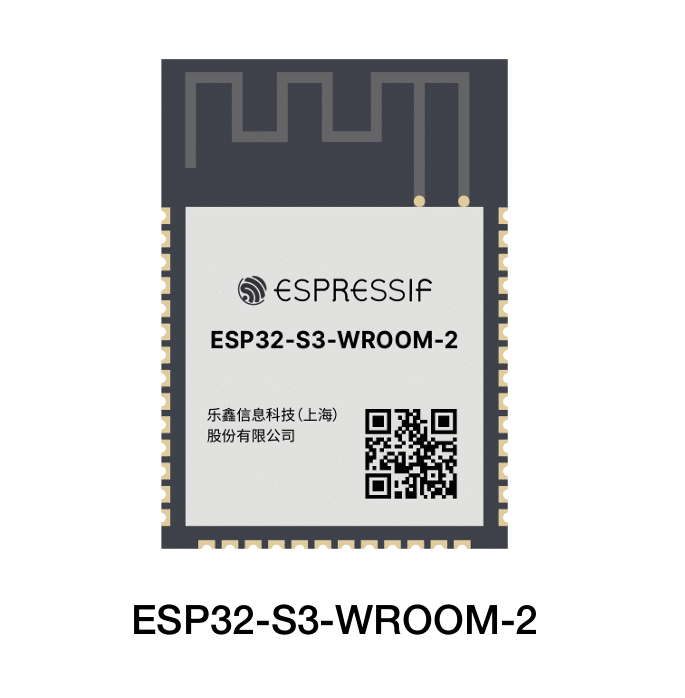
The ESP32-S3-WROOM-2 module series is mounted on a castellated PCB edge board design same as the WROOM-1. However, WROOM-2 is only available with a PCB antenna.
The microcontroller inside is an ESP32-S3R8V Xtensa® 32-bit LX7 CPU (with single precision floating point FPU) that operates at up to 240 MHz. It has both WiFi (802.11 b/g/n) and Bluetooth 5 (LE and Mesh) functionality. The list of peripherals of this microcontroller includes:
- GPIO (up to 33), SPI, LCD interface, Camera interface
- UART, I2C, I2S, remote control, pulse counter
- LED PWM
- full-speed USB 2.0 OTG, USB Serial/JTAG controller
- MCPWM, SDIO host
- GDMA, TWAI® controller
- ADC, touch sensor, temperature sensor
- timers and watchdogs
The ESP32-S3 Soc includes additional vector instructions for neural network computing and signal processing fit for AI and DSP specifc algorithms.
The memory variants of the ESP32-S3-WROOM-2 are:
| ESP32-S3-WROOM-2 | Flash | PSRAM |
|---|---|---|
| ESP32-S3-WROOM-2-N16R8V | 16 MB (Octal SPI) | 8 MB (Octal SPI) |
| ESP32-S3-WROOM-2-N32R8V | 32 MB (Octal SPI) | 8 MB (Octal SPI) |
Notice that the flash and PSRAM in a WROOM-2 is connected all in OctalSPI. An Octal SPI connection has a speed advantage over QuadSPI but has several more interface connections. The OctalSPI connection of WROOM-2 gives it faster access to its memories compared to a WROOM-1.
Below is the internal block diagram of an ESP32-S3-WROOM-2
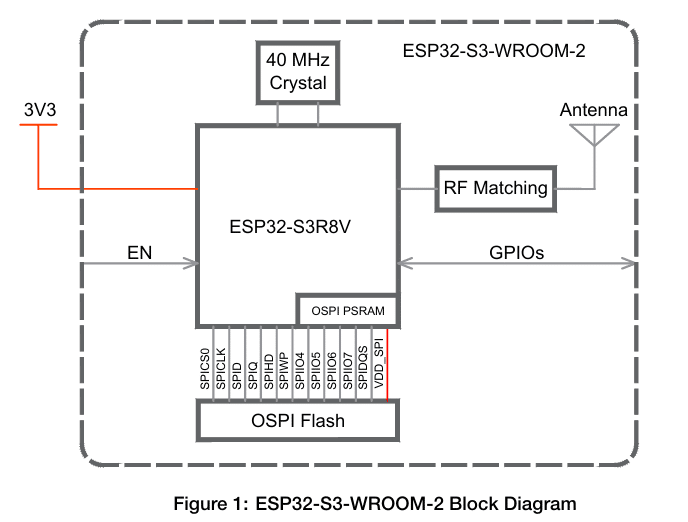
ESP32-S3-MINI-1 and 1U
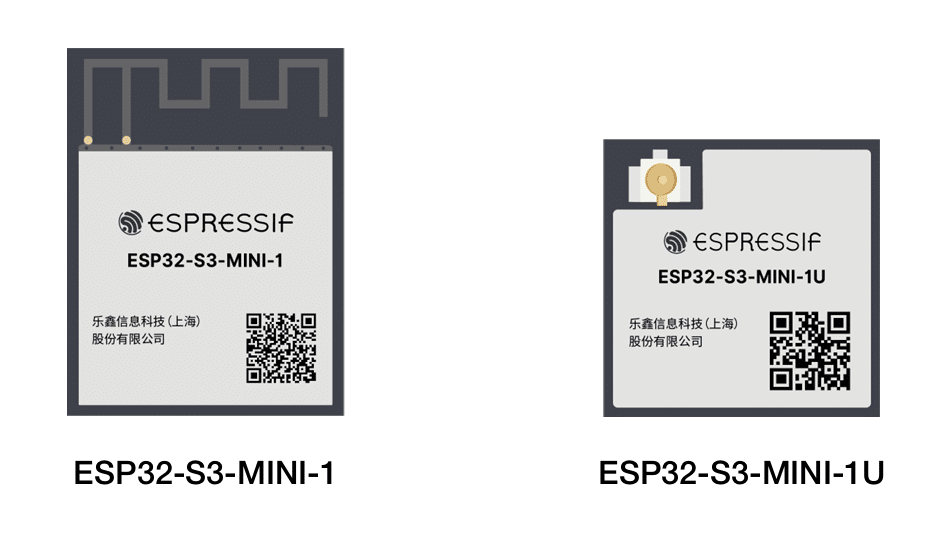
If you want a smaller module footprint, an ESP32-S3-MINI-1 is the way to go. However, the pads of this module is located underneath which may require you to do hot-air soldering. Additionally, this module is limited to having 2MB of extended PSRAM. ESP32-S3-MINI is available with PCB antenna (1) or antenna connector (1U).
The microcontroller inside is an ESP32-S3 SoC embedded Xtensa® dual-core 32-bit LX7 microprocessor (with single precision FPU), up to 240 MHz. It has both WiFi (802.11 b/g/n) and Bluetooth 5 (LE and Mesh) functionality. The list of peripherals of this microcontroller includes:
- GPIO (up to 39), SPI, LCD interface, Camera interface
- UART, I2C, I2S, remote control, pulse counter
- LED PWM
- full-speed USB 2.0 OTG, USB Serial/JTAG controller
- MCPWM, SDIO host
- GDMA, TWAI® controller
- ADC, touch sensor, temperature sensor
- timers and watchdogs
The ESP32-S3 Soc includes additional vector instructions for neural network computing and signal processing fit for AI and DSP specifc algorithms.
The memory variants of an ESP32-S3-MINI-1 are:
| ESP32-S3-MINI-1 | Flash | PSRAM |
|---|---|---|
| ESP32-S3-MINI-1-N8 | 8 MB(Quad SPI) | |
| ESP32-S3-MINI-1-N4R2 | 4 MB(Quad SPI) | 2 MB(Quad SPI) |
| ESP32-S3-MINI-1U-N8 | 8 MB(Quad SPI) | |
| ESP32-S3-MINI-1U-N4R2 | 4 MB (Quad SPI) | 2 MB (Quad SPI) |
Notice that the maximum extended PSRAM of this module an can reach up to 2MB only.
The internal block diagrams of the ESP32-S3-MINI-1 can be seen below:
